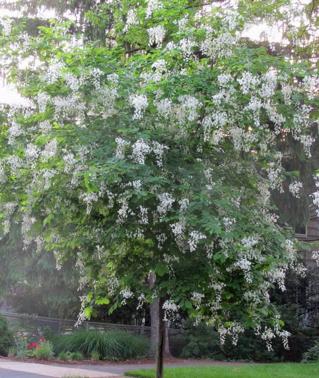

Sections
Highlight

Denise Bush
Tuesday, 27 June 2017, 08:38
Compartir
Cladastris is a genus of nine trees, eight which are native to Asia and one to America. Cladastris kentuckea from the US is a small to medium sized deciduous tree, 10 to 12 metres tall when fully grown, and with a rounded crown between 8 to 10 metres in diameter.
It is sometimes listed as C. lutea and the common name for this lovely tree is Yellow Wood. It is a member of the pea/bean family Fabaceae.
In spring the yellow-green, pinnate compound leaves (consisting of 7 to 11 leaflets) unfurl and soon turn bright green. The scented flowers look very similar to those of wisteria and are usually white. There is a pink variety called C. kentuckea Perkins Pink which is particularly beautiful and equally as fragrant. After flowering, the tree produces flat seed pods about five centimetres long.
Although Cladastris kentuckea will tolerate some drought when fully established, like most plants it will appreciate regular watering during its settling-in period and during hot weather. It will develop a deep, root system with few surface roots which means besides being able to grow shade-loving plants below it, you can also plant it close to patios and terraces where it will throw welcome shade in the summer.
Cladastris kentuckea needs a position with full sun. It is quite hardy but its branches are fragile so it needs to be protected from strong winds. It is not fussy about soil, growing well in both high ph and acid soils.
It can be propagated by seed or root cuttings but may take eight to ten years to flower. Pruning is rarely needed but if necessary, it is best carried out in the summer, not in spring or winter as the branches may bleed copiously. In autumn the leaves turn bright-yellow before falling.
The heart wood of C. kentuckea is yellow, hence the common name Yellow wood. It was once the source of a yellow dye and is sometimes used in furniture making, gun stocks and for wood-turning as it is very hard. The genus name comes from the Greek klados meaning branch and thraustos meaning fragile.
Publicidad
Publicidad
Publicidad
Publicidad
Reporta un error en esta noticia
Necesitas ser suscriptor para poder votar.